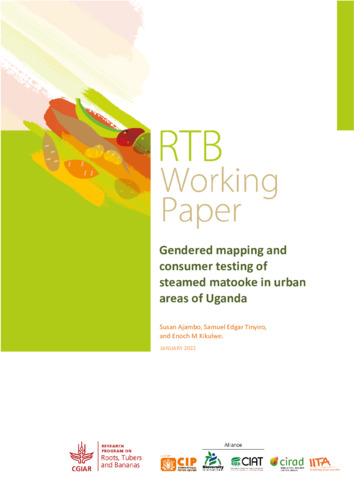Gendered mapping and consumer testing of steamed matooke in urban areas of Uganda
Abstract
Cooking banana or matooke is a key staple food for Ugandans, usually consumed in steamed form. Breeding interventions over the years have focused on increasing productivity for farmers especially in lieu of resolving constraints such as pests and diseases and adverse weather (drought). However, despite gains in productivity due to improved or superior cultivars, end-user uptake remained lukewarm. As a result, it was important to understand the underlying reasons for this leading to the studies that sought to investigate end-user preferences for the matooke consumed along the value chain beyond farmer fields. The current study focused on exploring the attributes of steamed matooke that are desirable or undesirable for urban consumers segregated by gender, age and income status. This approach is a useful precursor for targeted breeding of cultivars possessing consumers' preferred characteristics.
The study was conducted in Kampala and Wakiso. First, a gendered food mapping involving use of Focus Group Discussions (FGDs) and Individual Interviews (IDIs) was conducted. This was followed by a consumer test with 381 consumers where four steamed matooke samples/cultivars were evaluated namely, Nakitembe, Kibuzi, Ntika and Mpologoma. Steamed-mashed matooke was the most consumed form (97%) and with the highest frequency of consumption (83%). Of the cultivars assessed Kibuzi was most-preferred during the FGDs and also had the highest mean overall liking in the consumer test (7.2). Ntika was least-preferred (5.9). However, differences were observed among income classes and gender groups (sex and age). High- and low-income consumers gravitate towards steamed Kibuzi while for the middle income it was Mpologoma. The females (adult and youth) showed more preference for Mpologoma while the males liked Nakitembe more. The mapping of sensory characteristics showed that the key drivers of overall liking were a yellow color; a nice aroma; attractive looking; sweet (delicious, not sweet like sugar); Homogeneous (one color); good taste and soft. Matooke taste proved a key determinant for the preference of steamed Kibuzi over the other steamed matooke. It is therefore important to unlock this attribute in terms of sensory quantitative descriptive analysis and physico-chemical characterization, to guide breeding efforts geared towards improving sensory acceptability of matooke cultivars. Differences were observed in preference among different income and gender categories. Therefore, breeders need to package appropriate products based on the preferences of the various socio-demographic segments, including by gender and income class groupings to enhance new cultivar adoption.

